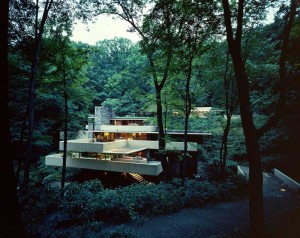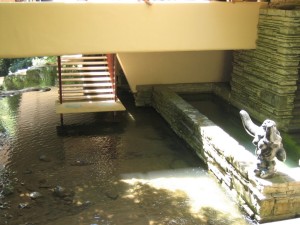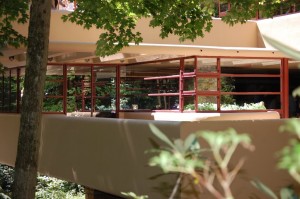Frank Lloyd Wright’s Fallingwater
by habituallychic
09 . 05 . 07 The only good thing about your family having a house in the middle of nowhere is that it’s only an hour away from one of the most famous houses in America, Frank Lloyd Wright’s Fallingwater, also in the middle of nowhere. I first visited the site over 20 years ago so I thought it was about time for a second look, which is what I did this past weekend. Although, wearing Christian Louboutin flats on the tour probably wasn’t the brightest idea I’ve ever had so if you plan to visit, I suggest taking along a pair of sneakers since a lot of the tour is outside.
The only good thing about your family having a house in the middle of nowhere is that it’s only an hour away from one of the most famous houses in America, Frank Lloyd Wright’s Fallingwater, also in the middle of nowhere. I first visited the site over 20 years ago so I thought it was about time for a second look, which is what I did this past weekend. Although, wearing Christian Louboutin flats on the tour probably wasn’t the brightest idea I’ve ever had so if you plan to visit, I suggest taking along a pair of sneakers since a lot of the tour is outside.
“Fallingwater is recognized as one of Wright’s most acclaimed works, and in a 1991 poll of members of the American Institute of Architects, it was voted “the best all-time work of American architecture.” It is a supreme example of Frank Lloyd Wright’s concept of organic architecture, which promotes harmony between man and nature through design so well integrated with its site that buildings, furnishings, and surroundings become part of a unified, interrelated composition.”

Fallingwater was designed in 1935 for the Edgar J. Kaufmann family of Pittsburgh, who owned the famous Kaufmann’s department store and vacationed in the Mill Run area of Pennsylvania. The family asked Wright to build a home near the Bear Run waterfall that they loved. What they didn’t expect was for Wright to design the house over the waterfall but they agreed to the plan and it was built almost exactly as it was planned. The interesting part of the story was that it was the Kaufmann’s son, Edgar Kaufmann, jr. who brought about the collaboration with Wright, who’s career was in a bit of a slump at the time.
“After having read Frank Lloyd Wright’s An Autobiography (1932) on the advice of a friend, he was inspired to join the Taliesin Fellowship, which Wright and his wife, Olgivanna, had recently founded as an institute for artistic growth. In September, Edgar jr. traveled to Wisconsin for an interview with Wright, and a month later he was officially inscribed as a member of the fellowship. His stay at Taliesin only lasted six months, however, and he returned to Pittsburgh in 1935 to take his long deferred place in the family store. Over the next seven years, he played a pivotal role in integrating the family’s interest in progressive design, in Wright’s work, and business.” He later went on to work for the Museum of Modern Art in New York and the family’s story is so interesting that it’s definitely worth reading online.
 One of the things that almost all visitors notice upon arrival to Fallingwater is how modern and contemporary it looks for a design that was finished in 1939. It is also the only great Wright house open to the public with its setting, original furnishings, and art work intact. Almost all of the original Wright-designed furnishings are still in place. Fine art, textiles, objets d’art, books, and furnishings collected by the Kaufmann family from the 1930’s through the 1960’s are on view, and represent the eclectic tastes of a sophisticated, world-traveled family. Included in the collections are works by Audubon, Tiffany, Diego Rivera, Picasso, Jacques Lipchitz, Richmond Barthe, and woodblock prints by Japanese artists Hiroshige and Hokusai – gifts from Frank Lloyd Wright to the Kaufmanns.
One of the things that almost all visitors notice upon arrival to Fallingwater is how modern and contemporary it looks for a design that was finished in 1939. It is also the only great Wright house open to the public with its setting, original furnishings, and art work intact. Almost all of the original Wright-designed furnishings are still in place. Fine art, textiles, objets d’art, books, and furnishings collected by the Kaufmann family from the 1930’s through the 1960’s are on view, and represent the eclectic tastes of a sophisticated, world-traveled family. Included in the collections are works by Audubon, Tiffany, Diego Rivera, Picasso, Jacques Lipchitz, Richmond Barthe, and woodblock prints by Japanese artists Hiroshige and Hokusai – gifts from Frank Lloyd Wright to the Kaufmanns.
 A few of my favorite aspects of Fallingwater is how the house follows the contours of the landscape and nature as seen in the beam that is curved to allow for the trunk of the tree above and how the boundaries of inside and out are blurred. The stair below start in the house and go directly down to the water above the waterfall below.
A few of my favorite aspects of Fallingwater is how the house follows the contours of the landscape and nature as seen in the beam that is curved to allow for the trunk of the tree above and how the boundaries of inside and out are blurred. The stair below start in the house and go directly down to the water above the waterfall below.  Building Fallingwater was a complicated and detailed operation, yet the resulting house seems to belong quietly in its setting. It fits into the hillside and extends out over the falls as if it has always belonged there. Within it, the areas for social life, privacy, and service are clearly separated but conveniently linked. Frank Lloyd Wright’s masterpiece continues to unite human life, architectural form, and nature.
Building Fallingwater was a complicated and detailed operation, yet the resulting house seems to belong quietly in its setting. It fits into the hillside and extends out over the falls as if it has always belonged there. Within it, the areas for social life, privacy, and service are clearly separated but conveniently linked. Frank Lloyd Wright’s masterpiece continues to unite human life, architectural form, and nature.
Even though it is in the middle of nowhere, it is definitely worth making a pilgrimage to Fallingwater to see one of the finest examples of architecture ever created. Just make sure you wear proper footwear!







14 Comments
What a lucky girl you are to have seen this masterpiece. What an outstanding family the Kaufmanns were to accept Frank Lloyd Wright’s plan in it’s entirety. They were what I would call Patrons of the Arts. This is an excellent post you have done and I hope I can have an opportunity to visit this monument. I did a small tribute to Falling Water on my Blog and linked it up to this inspiration quote:
‘Beauty is truth, truth beauty,—that is all Ye know on earth, and all ye need to know.’
Ode on a Grecian Urn – Keats
Great post. Fallingwater is truly the work of a genius. It is one of the sights that I have to see in my lifetime. Lucky girl. Thanks for sharing the images, some I had not seen before.
Gosh, you are so lucky to have gone thre and seen the house! What is most amazing about the house or unusual is that the best view of the land is not seen from inside the house, but from the outside. I had read once that the house was not in the best condition, structually – and that time has taken it’s toll, is that true? Also, is that Moroccan rug original tothe house oradded later, do you know? Great post, as usual.
Joni
I remember being insanely jealous when Angelina Jolie arranged a surprise, private tour for Brad Pitt. I must see this house someday! Great post.
Patricia, what a great quote! I’m going to have to remember that one. The Kaufmann’s were definitely patrons of the arts. I love that they donated the house to the Western Pennsyvania Conservancy to be preserved for future generations to enjoy!
Suzy, thanks! You’re really not supposed to post your own photos of Fallingwater…long story…but their site doesn’t show that many photos and so I had to post some so you could get a sense of the site, esp. since so many people don’t get the chance to visit.
Joni, the house definitely blurs the line between inside and outside. That’s the best part!
Fallingwater had a complete overhaul that was finished in 2002. The cantilevers continue to sag a little but they always did but now they are just reinforced.
Also, all of the furnishings and art are original to the house. The Kaufmann’s wanted visitors to see how the see the house as it was when they lived there, right down to the flowers. But, the rugs are reproductions of the originals so that visitors can walk on them.
Thanks Brilliant Asylum!
I was asking my friends and family if they heard about Brad and Angelina’s visit and if they knew what airport they flew into but no one could remember. It’s so in the middle of nowhere, it’s hard to imagine celebrities there.
Great post – I love Wright’s aesthetic and certainly Chicago has some wonderful examples. Like you, I also like how he incorporated the natural landscape into a design.
Most of all, I love the linear/geometic aspect that comes out in Fallingwater and other homes such as Robie House. I am always drawn to building lines and shapes around me every day so I guess it’s the simplicity of Wright’s approach in this particular style of architecture that I like.
This really was a special treat – I do so hope to visit. I bet this wasn’t the only good thing about the middle of nowhere!
Always one of my favorites – I have never had the opportunity to see it in person. How lucky you are.
Jackie
(sigh) http://www.paconserve.org/brad-angelina.htm
I don’t know why I thought it was so romantic, the architecture nerd in me perhaps?
Wonderful post. My fifteen year old son loves architecture and when he heard we’d be going back east for our family trip last summer, he asked if we could stop there. We took the tour and loved it. I’m excited to show him the blog when he gets home from school. Neat place.
Karey, thanks for your kind words! How wonderful of you to make the pilgrimage to Fallingwater for your son and how wonderful for him to have a love of architecture at such a young age!
He should definitely read The Fountainhead and check out my Edward Durell Stone posts from last month, http://habituallychic.blogspot.com/2007/08/apres-le-deluge.html and http://habituallychic.blogspot.com/2007/08/apres-le-deluge-part-deux.html. He was a great American architect.
Perhaps, a trip to Philip Johnson’s Glass House should be on the agenda for next year too!